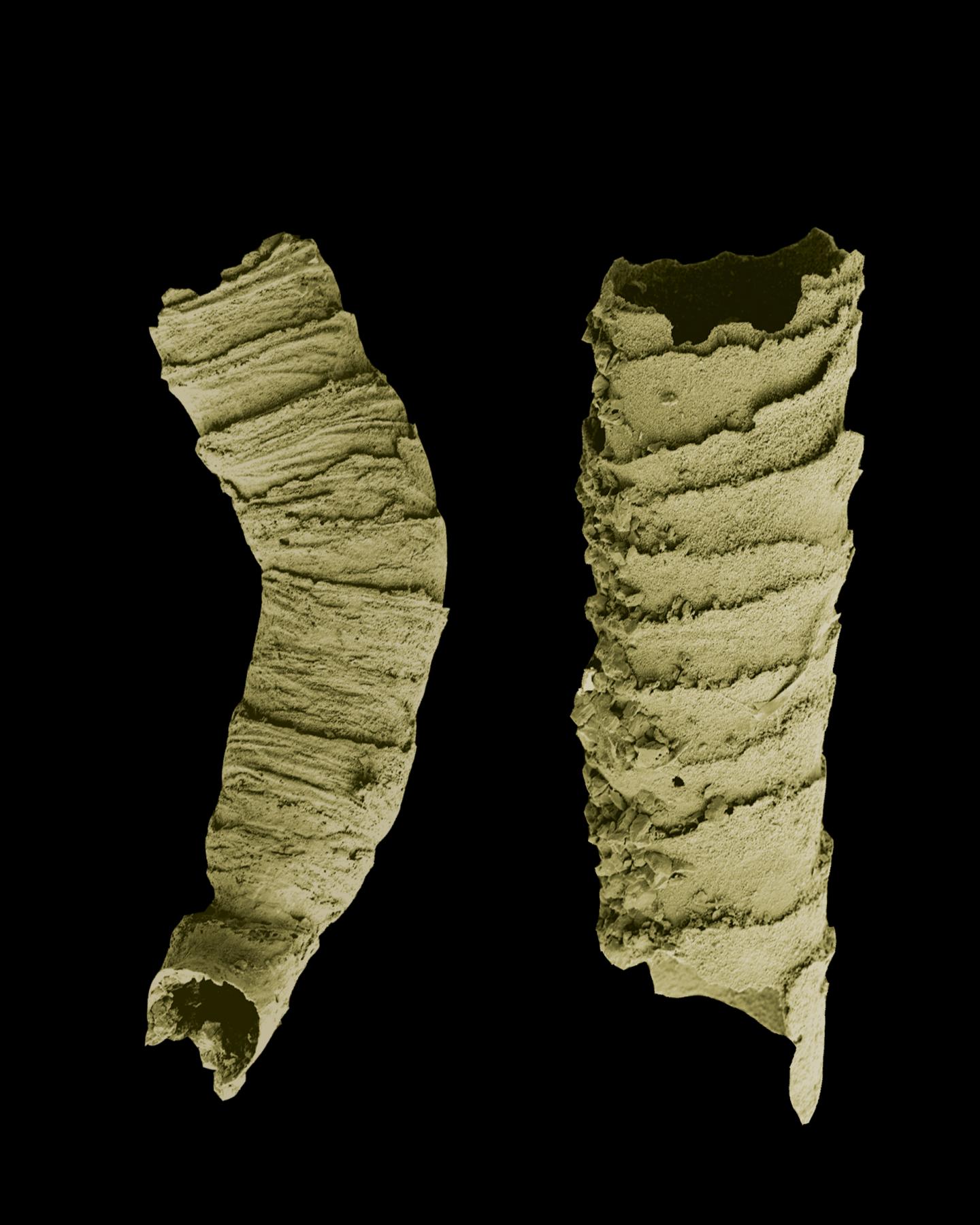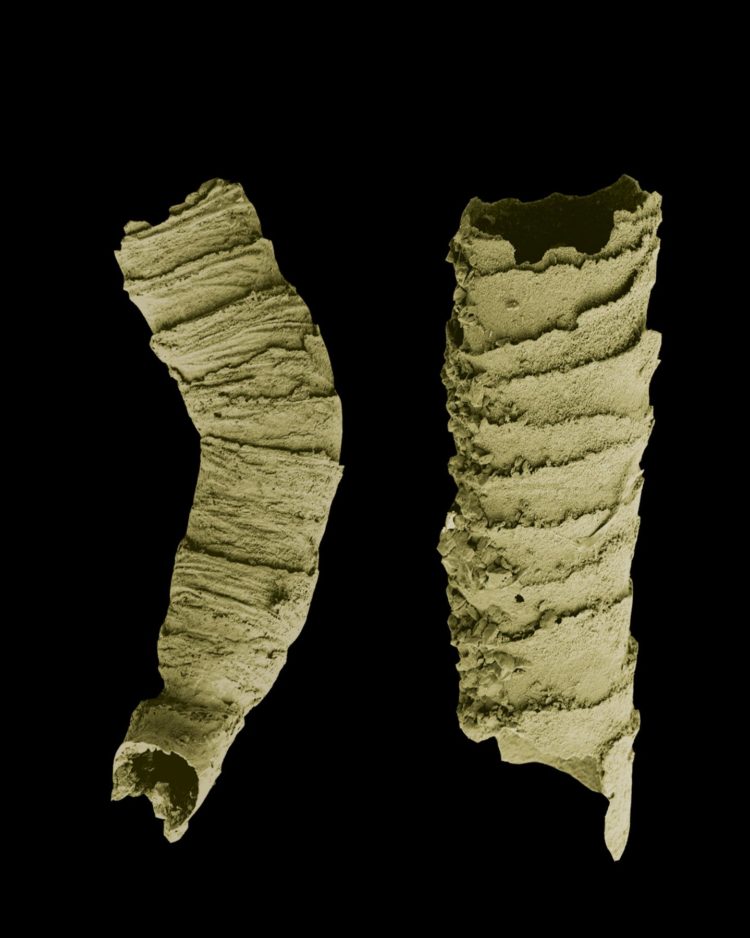Scientists will present research on the mechanical and physical properties of skeletal evolution, biomaterials, and aging at the APS March Meeting in Denver

Credit: Shuhai Xiao and Pupa U. P. A. Gilbert
DENVER, COLO., FEBRUARY 28, 2020–Studying the evolution of bodily processes millions of years ago as well as the properties of today’s biomaterials could improve soft robotics design and inform materials science research. At the 2020 American Physical Society March Meeting in Denver, scientists will present research on mineralized skeletons, other biomaterials, and the mathematics of aging.
Skeletal Evolution During the Cambrian Explosion
Animals began to evolve mineralized skeletons around 550 million years ago. Unlike their single-celled relatives, the protists, many of these animals quickly and independently evolved skeletons made from various minerals.
“It was a crazy time in Earth’s evolution,” said Susannah Porter, a paleontologist at the University of California, Santa Barbara. Porter and her colleagues wanted to understand when, why, and how mineralized skeletons convergently appeared during the Cambrian Period. Previously, her work showed that seawater chemistry had an important influence on the choice of minerals that animals used to make their skeletons. Porter wanted to see if there was a similar pattern in protists as well.
Their preliminary findings suggest seawater chemistry may be important for protists as well, although this is still a work in progress.. One clear result from this work, however, is that in contrast to animals, protists acquired their mineralized skeletons at various times thoughout the past 600 million years. The majority of animal skeletons were acquired in a short interval of time around the early Cambrian Period. This could reflect differences in why these groups evolved skeletons. A lot of animal skeletons seemed to be adapted for defense against predators. The appearance of carnivores in the early Cambrian Period might have triggered the widespread development of animal mineralized skeletons whereas the evolution of protists that eat protists didn’t.
Different Minerals, But the Same Crystallization Process
Starfish, sea urchins, mollusks, and corals, all have biomineralized skeletons or shells. They create these through particle attachment–a process by which nanoparticles of calcium carbonate attach to each other on the surface of a growing biomineral, gradually becoming skeletons or shells. The crystallization process is widespread among animals today, despite having no shared common ancestor.
“Biomineralization evolved independently in all these completely different phyla at different times during the last half a billion years,” said Pupa Gilbert, a physicist at the University of Wisconsin-Madison, “But always in the same way.”
Research by Gilbert and her team suggests that one of the first animals, Cloudina, was already forming its skeletons by particle attachment 550 million years ago. This was long before echinoderms, mollusks, and cnidaria even existed, suggesting that this process is als old as animal life itself. This is surprising, because Cloudina went extinct, and did not transmit down the lineage the information on how to make biominerals. If many species evolved particle attachment independently, it means that this formation mechanism is convergent, which in turn means that it is efficient and functional, according to Gilbert. Efficiency and functionality are extremely attractive characteristics, which inspire synthetic engineering of hard materials.
Elephant Trunks: Strong and Dexterous
Other biomaterials, like the elephant trunk, can be useful for soft robotics. The elephant trunk is a muscular hydrostat, or a structure that operates without skeletal support. Muscular hydrostats also include the human tongue and octopus tentacles. However, most aren’t equally flexible and strong at the same time.
“Elephants can pick up things as small as a tortilla chip as well as picking up 60 kg barbells (132.28 lbs),” said Andrew Schulz, a mechanical engineer at the Georgia Institute of Technology, “Soft robotics are usually very strong or very flexible, but the elephant trunk has the capability to be both.”
The team found elephant trunk skin is about 50% thicker than human forearm skin at its tip and roughly 800% thicker than human skin at its base. The skin also differs in wrinkle amplitude, or frequency of wrinkles, as well as whisker distribution. These differences make the African Elephant’s trunk particularly strong and dexterous.
Eggshell Diversity
Eggshells must be hard enough to incubate a baby chick but soft enough for the chick to pierce as it hatches. However, their properties have been largely unexplored with regards to evolutionary biology and biomechanics engineering.
“There are 10,000 living birds and we are just beginning to learn about the diversity of their eggshell designs,” said Mary Caswell Stoddard, an evolutionary biologist at Princeton University.
Stoddard and her team examined eggs from emus, a species of flightless Australian birds that lay dark greenish-blue eggs. They found the eggshell membrane is strong enough to stop the eggshell from shattering too early during the chick’s development. Emus belong to a clade of birds known as paleognaths, which are the oldest living birds. While some aspects of emus’ eggshells may have evolved specifically to suit their lifestyles, other properties could also apply to different bird species, said Stoddard.
Engineering Spider Silk-Inspired Polymer-Peptides
Spider silk looks wispy and fragile, but it is objectively tough. Toughness is the ability to absorb a high amount of energy before breaking. Inspired by spider silk’s toughness, new research examines how chemical structure can influence hybrid peptides’ mechanical properties.
“We were inspired… to design material systems that would allow you to take some of the elements of spider silk and utilize those in synthetic polymers in the solid state,” said LaShanda Korley, a chemical engineer and materials scientist at the University of Delaware.
She and her colleagues studied how the structural arrangement and connectivity of different polymer peptides can modulate mechanical properties like stiffness. The researchers found hybrid peptides where proteins folded over each other were tougher and stiffer. However, peptides with a helical structure were stretchier. The team plans to explore how structure can influence the properties of injectable gels and other materials.
Calculating Mortality
All species follow the same life cycle and age over time. Now, one physicist believes aging can be explained mathematically.
To better understand the mathematical processes behind aging, Mark Edelman, a physicist at Yeshiva University, used fractional calculus to determine the maximum lifespan a human being can achieve. Edelman posits this model may explain how our automatic muscle memory decays as we age.
###
Evolutionary Patterns in Skeletal Biomineralization
TIME/DATE/PLACE: 9:12 AM-9:48 AM, Tuesday, March 3, 2020, Room: 303
CONTACT: Susannah Porter, [email protected]
Biomineralization by Particle Attachment in Early Animals
TIME/DATE/PLACE: 9:48 AM-10:00 AM, Tuesday, March 3, 2020, Room: 303
CONTACT: Pupa Gilbert, [email protected]
African Elephant Sensing Capabilities through Skin and Hair
TIME/DATE/PLACE: 4:06 PM-4:18 PM, Tuesday, March 3, 2020, Room: 303
CONTACT: Andrew Schulz, [email protected]
The Avian Eggshell: Evolution and Engineering of a Tough, Lightweight Biological Material
TIME/DATE/PLACE: 8:00 AM-8:36 AM, Tuesday, March 3, 2020, Room: 303
CONTACT: Mary Caswell Stoddard, [email protected]
Silk-Inspiration: Hierarchy, Assembly, and Mechanics in Polyurea-Polypeptide Hybrids
TIME/DATE/PLACE: 2:30 PM-3:06 PM, Monday, March 2, 2020, Room: 504
CONTACT: LaShanda Korley, [email protected]
Evolution of Systems with Power-Law Memory: Do We Have to Die?
TIME/DATE/PLACE: 9:12 AM-9:24 AM, Thursday, March 5, 2020, Room: 304
CONTACT: Mark Edelman, [email protected]
ABOUT THE MEETING
The American Physical Society (APS) March Meeting is a major international conference and the largest physics meeting of the year. In 2020, the APS March Meeting will convene from March 2-6 at the Colorado Convention Center in downtown Denver.
Useful Links
Meeting website: https:/
Scientific program: http://meetings.
Press services: https:/
Hotel & Travel information: https:/
Press Registration
Complimentary registration is available to journalists for the express purpose of gathering and reporting news and information from the meeting. Staff reporters, freelance writers, and students are welcome to apply. Press credentials may be obtained by completing the form on this page: https:/
Press Conferences
All press conferences will take place in Room 608. If you are unable to attend, you may register to watch and ask questions online at https:/
Press Room
A press room for registered journalists will operate throughout the meeting in Room 610/612 and will offer complimentary coffee, breakfast, and lunch. The press room may be reserved for conducting interviews.
Hours
Monday – Thursday, 7:30 a.m. – 6:00 p.m.
Friday, 7:30 a.m. – 2:45 p.m.
Please contact the APS Press Office with any questions at [email protected].
ABOUT APS
The American Physical Society is a nonprofit membership organization working to advance and diffuse the knowledge of physics through its outstanding research journals, scientific meetings, and education, outreach, advocacy, and international activities. APS represents over 55,000 members, including physicists in academia, national laboratories, and industry in the United States and throughout the world. Society offices are located in College Park, Maryland (Headquarters), Ridge, New York, and Washington, D.C.
Media Contact
APS Press Office
[email protected]
301-209-3090





